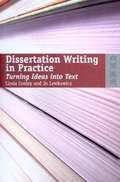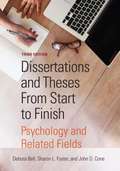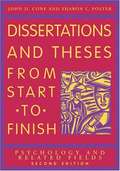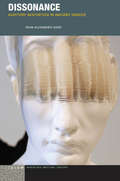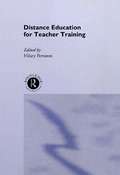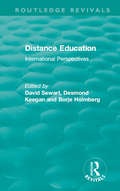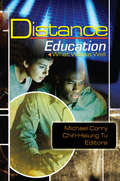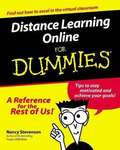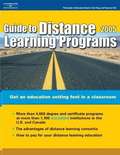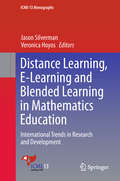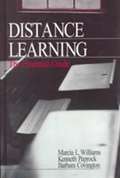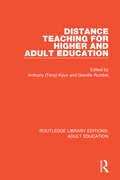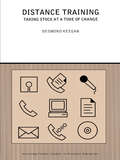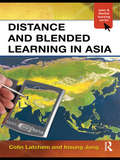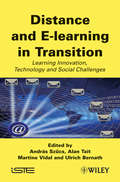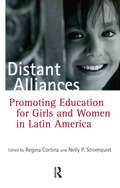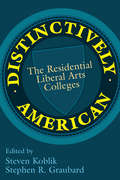- Table View
- List View
Dissertation Research and Writing for Built Environment Students
by Shamil G. NaoumDissertation Research and Writing for Built Environment Students is a step-by-step guide to get students through their final year research project. Trusted and developed over three previous editions, the new fourth edition shows you how to select a dissertation topic, write a proposal, conduct a literature review, select the research approach, gather the data, analyse and present the information and ultimately produce a well-written dissertation. The book simplifies dissertation research and writing into a process involving a sequence of learnable activities and divides the process into three parts. Part One covers the necessary groundwork, including: identifying the problem, writing a proposal and reviewing the literature. Part Two covers the research design and includes: approaches and techniques for data collection and constructing and sampling a questionnaire. Part Three covers: measurement of data, analysis of data with SPSS, structuring and writing the whole dissertation, and supervision and assessment. This new edition is packed with updated examples and research samples, making this the ideal resource for students involved in research in built environment subjects such as construction management, construction project management, facilities management, real estate, building surveying, quantity surveying and civil engineering.
Dissertation Writing in Practice
by Linda Cooley Jo LewkowiczThis book is designed to raise students' awareness of the linguistic features of a postgraduate dissertation/thesis written in English. It deals primarily with the linguistic aspects of extended pieces of writing, placing great emphasis on the writer's responsibility for the readability of the text. Each of the features introduced is illustrated through examples taken from authentic writing at the appropriate level. In addition, each chapter has a number of tasks to help students put into practice the skills that have been introduced. This book is mainly designed to help research students whose first language is not English, but it should also prove useful to native speakers of English, many of whom lack extensive experience of writing at this level. It can be used as a textbook for postgraduate students on a dissertation/thesis writing course, and may also be used as a self-study guide since an annotated answer key is provided for all the tasks. This book takes a realistic approach to helping students who may find the extended writing required at postgraduate level a daunting task; although it provides ample opportunities for practice, it does not expect students to produce extensive writing beyond that required for their degree.
Dissertations and Theses From Start to Finish: Psychology and Related Fields
by Debora J. Bell Dr. Sharon L. Foster Dr. John D. ConeDissertations and Theses From Start to Finish, now updated and revised to reflect changes to the APA's Publication Manual, Seventh Edition! For over twenty-five years, Cone and Foster's useful book has guided student writers through the practical, logistical, and emotional struggles that come with writing dissertations and theses. It offers guidance to students through all the essential steps, including: Defining topics; Selecting faculty advisors; Scheduling time to work on the project, and; Conducting, analyzing, writing, presenting, and publishing research. This third edition of this bestselling work follows new guidelines from APA's Publication Manual, Seventh Edition, and includes questions to help steer research, checklists, diagrams, and sample research papers. It also reflects the most recent advances in online research and includes fully updated online resources. Each chapter begins with an Advance Organizer that offers an at-a-glance summary of chapter content and applicability for different types of readers. Chapters also include significantly expanded To Do and Supplemental Resource lists, as well as helpful suggestions for dealing with common &“traps&” that recur throughout the writing process. The authors also consider the variety of roles faculty advisors play, and of variations in the thesis and dissertation process and requirements across institutions of higher learning.
Dissertations and Theses from Start to Finish: Psychology and Related Fields
by John D. Cone Sharon L. Foster Debora J. BellThis book includes questions to help steer research, checklists, diagrams, and sample research papers. It also reflects the most recent advances in online research and includes fully updated online resources. Each chapter begins with an Advance Organizer that offers an at-a-glance summary of chapter content and applicability for different types of readers. Chapters also include significantly expanded To Do and Supplemental Resource lists, as well as helpful suggestions for dealing with common "traps" that recur throughout the writing process. The authors also consider the variety of roles faculty advisors play, and of variations in the thesis and dissertation process and requirements across institutions of higher learning.
Dissertations and Theses from Start to Finish: Psychology and Related Fields
by John D. Cone Sharon L. FosterA book written by two long-time professors to help graduate students in psychology and related fields negotiate the thesis and dissertation process from beginning to end. Annotation c. by Book News, Inc., Portland, Or.
Dissonance: Auditory Aesthetics in Ancient Greece (Idiom: Inventing Writing Theory)
by Sean Alexander GurdIn the four centuries leading up to the death of Euripides, Greek singers, poets, and theorists delved deeply into auditory experience. They charted its capacity to develop topologies distinct from those of the other senses; contemplated its use as a communicator of information; calculated its power to express and cause extreme emotion. They made sound too, artfully and self-consciously creating songs and poems that reveled in sonorousness. Dissonance reveals the commonalities between ancient Greek auditory art and the concerns of contemporary sound studies, avant-garde music, and aesthetics, making the argument that “classical” Greek song and drama were, in fact, an early European avant-garde, a proto-exploration of the aesthetics of noise. The book thus develops an alternative to that romantic ideal which sees antiquity as a frozen and silent world.
Distance Counseling and Supervision: A Guide for Mental Health Clinicians
by Jennifer Nivin Williamson Daniel G. WilliamsonThis landmark primer in telebehavioral health addresses the functional elements of technology-assisted therapy with individuals, couples, and families. Leaders and innovators in the field contribute unique perspectives to help students and practitioners prepare for and productively engage in virtual counseling and supervision. Using reader-friendly language, the authors discuss ethical, legal, regulatory, and practical considerations for using the right technology in secure and confidential ways to best serve clients and supervisees. Diverse case scenarios, questions for further discussion, and useful appendices enhance this rich and current resource. Requests for digital versions from ACA can be found on www.wiley.com To purchase print copies, please visit the ACA website here Reproduction requests for material from books published by ACA should be directed to permissions@counseling.org
Distance Education for Teacher Training
by Hilary PerratonFirst published in 2002. Routledge is an imprint of Taylor & Francis, an informa company.
Distance Education: International Perspectives (Routledge Revivals)
by Desmond Keegan David Sewart Börje HolmbergDistance education, for long the Cinderella of the educational spectrum, had emerged in the 1970s and early 1980s as a valued component of many national educational systems in both developed and developing countries. The foundation of the Open Universities, developments in communications technology and in audio-, video- and computer-based learning, a new sophistication in the design of print-based materials and better support systems for the student learning at a distance had all contributed to the availability and quality of distance education programmes. Originally published in 1988, this book chronicles this great change in distance education. It presents the best writings on the subject published during the previous ten years. The articles selected for this volume provided a new scholarly basis for the theory and practice of distance education. The editors have brought together contributions from many countries and present authoritative introductions to each of the nine sections. This book provided those in both developed and developing countries with a guideline to one of the most rapidly expanding areas of education at the time.
Distance Education: International Perspectives (Routledge Studies in Distance Education)
by Desmond Keegan Keith Harry Magnus JohnAlthough distance education has developed rapidly over the past decade, writing on the subject is still scattered over a diverse range of often inaccessible sources. This book brings together a selection of the best writing on distance education in recent years, and is an essential reference for all who work in the field.
Distance Education: What Works Well
by Michael CorryDon&’t start from scratch! Learn what works-and what doesn&’t-in providing education to off-campus students! This unique compilation presents practical advice on how to set up distance learning programs that effectively serve the needs of students who don&’t have access to the campus. The book examines issues surrounding development, implementation, teacher training, time management, and other important aspects of distance education. Distance Education: What Works Well brings you lessons garnered from real-life experiences at several institutions to help you explore the pros and cons of distance education-and what it takes to implement a distance program that really works. In the first half of Distance Education: What Works Well you&’ll examine: the development of a digital high school-from the early stages through "rookie camp" experiences practical recommendations on how to design successful online high school programs what has worked well-and what has not-in terms of distance education in the rural K-12 environment the successful and not-so-successful aspects of an innovative distance education project that encourages collaboration between high schools and middle schools The second half of this informative book presents practical advice to help you set up distance learning programs that make the most of available technology. You&’ll learn: how to train faculty to effectively use distance education techniques the importance of student-teacher and student-student interaction in a distance education setting-and how to build active online communities that keep students and faculty in touch the roles and functions of moderators in online education-and the skills they need to be effective six effective tactics designed to optimize online time how to decide whether distance education is the right choice for you
Distance Learning Online for Dummies
by Nancy StevensonDistance Learning Online For Dummies is your perfect resource for navigating the rocky waters of distance learning. Find the right school for you, figure out the costs of classes, get registered, and go to school. Each step along this path can be intimidating, unless you have this book! Author Nancy Stevenson makes getting over these hurdles fun, with practical advice that will get you working towards that degree in no time at all. Once you're in class, she'll still be there to help you with correct etiquette for the virtual classroom, study tips, and advice on the best web tools to complement your learning experience! Includes a chapter on distance learning for people with disabilities.
Distance Learning Programs 2005
by Peterson'sFeatures include: Descriptions of more than 3,500 degree and certificate programs; Financial aid options specifically for distance learners; Accreditation--what it's all about and why it's important; Information on distance learning consortia--the next big thing in distance learning; Tips on choosing the right program.
Distance Learning, E-Learning and Blended Learning in Mathematics Education: International Trends in Research and Development (ICME-13 Monographs)
by Jason Silverman Veronica HoyosThis book builds on current and emerging research in distance learning, e-learning and blended learning. Specifically, it tests the boundaries of what is known by examining and discussing recent research and development in teaching and learning based on these modalities, with a focus on lifelong mathematics learning and teaching. The book is organized in four sections: The first section focuses on the incorporation of new technologies into mathematics classrooms through the construction or use of digital teaching and learning platforms. The second section presents a wide range of perspectives on the study and implementation of different tutoring systems and/or computer assisted math instruction. The third section presents four new innovations in mathematics learning and/or mathematics teacher education that involve the development of novel interfaces’ for communicating mathematical ideas and analyzing student thinking and student work. Finally, the fourth section presents the latest work on the construction and implementation of new MOOCs and rich media platforms developed to carry out specialized mathematics teacher education.
Distance Learning: The Essential Guide
by Marcia L. Williams Kenneth Paprock Barbara CovingtonExamines issues relevant to distance learning, such as skills needed by teleteachers/teletrainers, integrating current equipment with new technology, and educational research.
Distance Relationships
by Mary HolmesDrawing on interviews with UK couples in distance relationships, this book seeks to explain, evaluate and advance sociological debates about intimate life. It provides a rich and human perspective on how bodies, emotions and connections to others are key in maintaining intimate relationships.
Distance Teaching For Higher and Adult Education (Routledge Library Editions: Adult Education)
by Anthony Tony Kaye And Greville RumbleOriginally published in 1981 this volume provides a detailed analysis of the factors - strategic, pedagogic, operational, organisational and financial -which should be taken into account in the planning and running of large-scale, centralised distance education systems at the higher education level. The book uses evidence drawn from Open University type institutions in Canada, Costa Rica, Germany, Iran, Israel, Pakistan, Spain, Sri Lanka, Venezuela and the UK.
Distance Teaching for the Third World: The Lion and the Clockwork Mouse (Routledge Library Editions: Development)
by Michael Young Hilary Perraton Janet Jenkins Tony DoddsThis reissue, first published in 1980, is based on the experiences of the International Extension College in developing distance teaching. The volume begins by reviewing the world problems of educational quality and quantity, and then examines the ways in which print, broadcasts and group study have been used to train teachers, to improve classroom education, to teach by correspondence out of school, and to support rural development. It then considers how that experience can be used, perhaps by creating a network of radio colleges, to supplement and extend existing schools and colleges. Finally, the book includes a descriptive and annotated bibliography of over 100 distance teaching projects in 65 third world countries.
Distance Training: Taking Stock at a Time of Change (Routledge Studies In Distance Learning Ser.)
by Desmond KeeganDespite the massive potential of distance learning on the internet, the field of distance training is little known or understood. This guide addresses this knowledge gap and: *presents research into four models of distance education, into which it is claimed nearly all provision world-wide falls*provides a global overview of distance education and training *examines case studies of distance education establishments providing insight into their structure and advantages *challenges the premise that distance training lacks academic exellence and status *appraises the role of distance education as a tool for employers to provide more effective and efficient training for employees.Born in the nineteenth century, distance training came of age in the twentieth century. Desmond Keegan presents an overview of distance training from its inception and looks forward to the innovations of the future.
Distance and Blended Learning in Asia (Open and Flexible Learning Series)
by Insung Jung Colin LatchemDistance and Blended Learning in Asia is a unique and comprehensive overview of open, distance learning (ODL) and information and communication technology (ICT) in Asian education and training. Broad in coverage, this book critically examines ODL and ICT experiences from Japan to Turkey and from Sri Lanka to Mongolia – drawing conclusions from the successes and failures, and recommending ways in which planning, management and practice may be developed for the world’s largest concentration of adult open and distance learners. This pioneering book draws on Asian theory, research and practice to identify the strengths, weaknesses and challenges in all sectors of Asian education and training. It critically and insightfully discusses the ideas, skills and practices that are necessary to advance knowledge in leadership and management, professional development, innovation and quality assurance and research and diffusion. Distance and Blended Learning in Asia provides an insightful, informative and critical review of ODL / ICT developments in schools, open schooling, colleges, universities, workplace training, professional development and non-formal adult and community education. The book is an invaluable reference for ODL / ICT professionals, educators and students anywhere in the world, and is essential reading for all of those involved in ODL / ICT in Asia.
Distance and E-learning in Transition: Learning Innovation, Technology and Social Challenges
by Martine Vidal Alan Tait Ulrich Bernath András SzücsThe rushed development of information and communication technologies and their impact on the world of learning in the last decade have profoundly changed the paradigms, scenarios and values at all levels of education. The professionalization of tools and practices, in addition to the consolidation of academic and practical knowledge, has been a major continuing issue throughout these years. The annual conferences of the largest European professional community in distance and e-learning have been setting the landmarks in this process. The selection from this unique knowledge pool demonstrates the deepening and consolidation of knowledge and experience. This book presents the developments in the field of open, distance and e-learning, through new technologies, methodologies and tools, which have profoundly changed the paradigms, scenarios and values at all levels of education over the last decade.
Distant Alliances: Gender and Education in Latin America (Reference Books in International Education)
by Regina Cortina Nelly P. StromquistIn this ground-breaking study, Regina Cortina and Nelly Stromquist examine how the alliances of international agencies, national governments, and nongovernmental organizations have strengthened public support for educating girls and women in Latin America. Bringing a timely and readable account of the strategies pursued, the authors show how the strength of the women's movement has influenced the education of women and girls, and thus has helped to reduce poverty and strengthen the citizenship of women in developing countries. The book's overview of recent initiatives, along with its illuminating case studies of developing nations, offers the reader a window into educational reform and the realities of social change in Latin America.
Distant Readings of Disciplinarity: Knowing and Doing in Composition/Rhetoric Dissertations
by Benjamin MillerIn Distant Readings of Disciplinarity, Benjamin Miller brings a big data approach to the study of disciplinarity in rhetoric, composition, and writing studies (RCWS) by developing scalable maps of the methods and topics of several thousand RCWS dissertations from 2001 to 2015. Combining charts and figures with engaging and even playful prose, Miller offers an accessible model of how large-scale data-driven research can advance disciplinary understanding—both answering and amplifying the call to add replicable data analysis and visualization to the mix of methods regularly employed in the field. Writing studies has long been marked by a multitude of methods and interlocking purposes, partaking of not just humanities approaches but also social scientific ones, with data drawn from interviews and surveys alongside historical and philosophical arguments and with corpus analytics in large-scale collections jostling against small-scale case studies of individuals. These areas of study aren’t always cleanly separable; shifting modes mark the discipline as open and welcoming to many different angles of research. The field needs to embrace that vantage point and generate new degrees of familiarity with methods beyond those of any individual scholar. Not only a training genre and not only a knowledge-making genre, the dissertation is also a discipline-producing genre. Illustrating what the field has been studying, and how, Distant Readings of Disciplinarity supports more fruitful collaborations within and across research areas and methods.
Distant View of a Minaret (SparkNotes Literature Guide Series)
by SparkNotesDistant View of a Minaret (SparkNotes Literature Guide) by Alifa Rifaat Making the reading experience fun! Created by Harvard students for students everywhere, SparkNotes is a new breed of study guide: smarter, better, faster.Geared to what today's students need to know, SparkNotes provides:chapter-by-chapter analysis explanations of key themes, motifs, and symbols a review quiz and essay topics Lively and accessible, these guides are perfect for late-night studying and writing papers.
Distinctively American: The Residential Liberal Arts Colleges
by Stephen R. Graubard Steven KoblikThere is much change underway in American higher education. New technologies are challenging the teaching practices of yesterday, distance learning is lauded, and private firms offer to certify the educational credentials that businesses and others will deem satisfactory. In this new environment, America's liberal arts colleges propound a quite different set of values. Their continuing faith in the liberal arts--not as the nineteenth century chose to define them but as the twenty-first century will be obliged to reconsider them--is being tested.Distinctively American examines the American liberal arts college as an institution, from its role in the lives of students, to its value as a form of education. It explores the threats faced by liberal arts colleges as well as the transformative role, both positive and negative, information technology will play in their future development and survival. In the preface introducing the volume, Stephen Graubard examines the history of the American liberal arts colleges, from their early disdained reputations in comparison to European schools, to their slow rise to becoming "world-class universities."This important volume explores the triumphs and challenges of one segment of the American higher educational universe. It also addresses a larger question: What ought this country be teaching its young, the many millions who now throng its colleges and universities? Distinctively American is essential reading for all concerned with the future of higher education.

